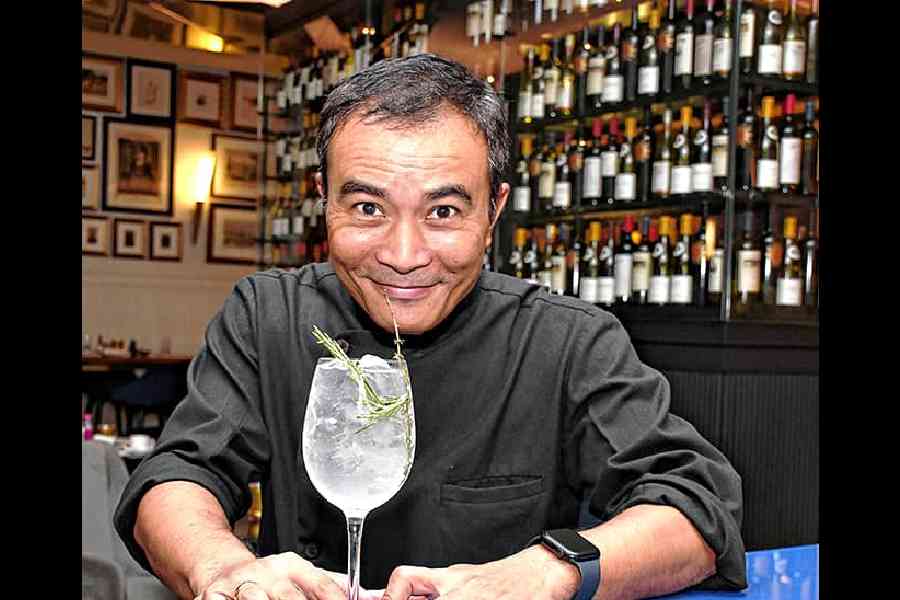The Bar at The Oberoi Grand welcomed one of India's finest mixologists, Yangdup Lama, in association with Hapusa Himalayan Dry Gin on September 8. Lama, co-founder of Sidecar (which has secured the 18th spot among Asia’s 50 best bars in 2023), kept guests in awe with his creative spin on the Hapusa Gin, a Himalayan Juniper-inspired gin.
On the sidelines of an aromatic and insightful evening, t2 got Lama, the author of Cocktails & Dreams: The Ultimate Indian Cocktail Book, who calls himself an "accidental bartender", speaking about the versatility of the indigenous gin and India’s evolving bartending scene.
Tell us about the cocktail menu you presented today.
The four cocktails are a pure depiction of how versatile and precious our gin is. Whenever we think of cocktails, the most important thing is the role that the spirit plays in creating the drink, from bringing the right balance to blending the right flavours and character. In terms of the variation, we are trying to keep all four drinks in four different styles, in terms of flavour, process and presentation.
Tell us about the process...
The first one is called NY Sour. It’s a shaken drink. A classic cocktail, it contains Hapusa, which is the spirit. We shake it with lime and sugar, and after that, we do a red wine flip, which is basically shaking it up and serving it straight up in a nice coupe or cocktail glass. With a red wine float on top, it’s finished with tinctures of red chilli oil.
The second one is the Gondhoraj Gimlet. So the gimlet is a very classic cocktail, which is just gin and lime cordial, or homemade lime cordial. What we’ve done is we’ve used the regional lime, which is gondhoraj and made a cordial out of the same. And we’ve taken the gin with the gondhoraj cordial, shaken it and served it straight up with some gondhoraj zest on top. So it’s a fairly simple drink, a variation of the classic gimlet.

The third one is called Botanist. The basic gin is Hapusa, which goes with some lime and sugar, and a touch of cardamom tincture is stirred, filled with lots of ice, and then topped with soda. And it’s finished with burned rosemary and thyme.
The last one is Frozen Basil Smash. While the other drinks are either served straight up or served over ice, the last one is a frozen drink. The basil is nice and refreshing. Hapusa gin goes with some lime and sugar, and it’s blended with fresh basil sprigs. You can’t feel the alcohol, but what delights you is a nice and refreshing flavour.
Is there a specific way to preserve these drinks if one is not consuming them immediately?
So Frozen Basil Smash could be a bit difficult. Unless you keep it frozen, it’s going to make things tougher. It’s made nice and fresh and you better consume it within the next half an hour. The first thing you do is always make it and bottle it because it’s a straight-up drink. So anything that has no ice and is served without ice, can be put in a bottle, kept in the refrigerator and consumed whenever you wish to.
How was your experience taking over the bar in this iconic hotel today?
It’s wonderful to be back in Calcutta because I’m a Calcutta boy. I did my college from The Bhawanipur Education Society College. I’m quite acquainted with the city. Takeovers are a wonderful thing because then you bring in a different talent from a different city or a different bar to offer something different to your consumers. So it’s a great initiative by The Oberoi Grand.
What made you interested in bartending?
I was used to cooking at home. During my course in hotel management at IAM, Salt Lake, I found F&B to be very interesting. But when I finished my education in Calcutta and went on to join Hyatt Regency in Delhi, I was sent to the bar. That’s why I always call myself an accidental bartender.
How do you perceive the Indian bartending scene?
It’s in great shape and at par with anywhere else across the globe. Currently, there’s a lot of talent here and tier-one cities are doing extremely well in the cocktail scene. The bar scene is changing with time; you see amazing Indian talent doing extremely well outside of India as well. So we have some of the best bartenders from India working in Hong Kong, Kuala Lumpur, Singapore, New York and London. What is different about the present cocktail-making scene in India is that in the bygone years, we would always talk about Western flavours, but now we are actually telling the Indian story to the rest of the world through our cocktails. It is being well accepted by the global audience.
What are some of the basic principles of bartending that aspirants should follow?
We always take the simpler things for granted. I always say “make a simple Whiskey Soda”. Instead of always focusing on the fancy things, make sure the basics are made right. Last but not least, you have to have a certain discipline, when it comes to being in this profession. We are dealing with a very sensitive product, which is alcohol. One shouldn’t be carried away because there’s so much alcohol around. It’s great to enjoy alcohol but not abuse it.
